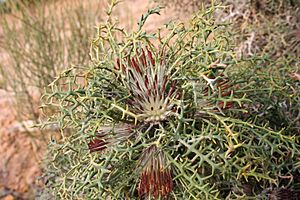Banksia erythrocephala facts for kids
Quick facts for kids Banksia erythrocephala |
|
|---|---|
 |
|
| Near Kondinin | |
| Scientific classification | |
| Genus: |
Banksia
|
| Species: |
erythrocephala
|
| Synonyms | |
|
Dryandra erythrocephala C.A.Gardner |
|
The Banksia erythrocephala is a type of prickly shrub. It is found only in Western Australia. This plant has straight stems and leaves with sharp points. Its flowers can be cream-coloured and reddish-black, or all cream and yellow. It also produces egg-shaped fruits.
Contents
What Does Banksia erythrocephala Look Like?
This Banksia is a shrub that grows straight up. It can reach about 1.7 metres (about 5.5 feet) tall. It has a special underground stem called a lignotuber. This helps the plant regrow after a fire.
Its leaves are long and narrow, about 6 to 11 centimetres (2.4 to 4.3 inches) long. They are 1 to 1.6 centimetres (0.4 to 0.6 inches) wide. Each leaf has two to six sharp, pointed parts on its sides.
The flowers grow in a round head. Each head has between 15 and 26 flowers. At the bottom of the flower head are long, thin leaves called bracts. The flowers themselves can be dull reddish-black and cream, or completely yellow. This depends on the type of Banksia erythrocephala. They are about 2.3 to 4 centimetres (0.9 to 1.6 inches) long.
The plant flowers from October to December, or from January to June. After flowering, it produces egg-shaped fruits called follicles. These fruits are about 0.8 to 1.1 centimetres (0.3 to 0.4 inches) long.
How Was Banksia erythrocephala Named?
This plant was first officially described in 1928. A botanist named Charles Austin Gardner gave it the name Dryandra erythrocephala. He wrote about it in a science journal after collecting samples in 1926.
Later, in 1996, another botanist named Alex George found two different types, or varieties, of this plant:
- Dryandra erythrocephala var. erythrocephala: This type has reddish-black and cream-coloured flowers.
- Dryandra erythrocephala var. inopinata: This type has all yellow flowers.
In 2007, two scientists, Austin Mast and Kevin Thiele, moved all Dryandra plants into the Banksia group. So, this plant became Banksia erythrocephala. The second part of its name, erythrocephala, comes from ancient Greek words. It means "red" and "headed," likely referring to the colour of some of its flowers.
The two varieties also got new names to match the Banksia group.
Where Does Banksia erythrocephala Live?
The Banksia erythrocephala var. erythrocephala grows in a type of shrubland called kwongan. You can find it between towns like Kulin, Nyabing, and east of Hyden in Western Australia.
The other type, Banksia erythrocephala var. inopinata, also grows in kwongan areas. It has been seen near Dumbleyung, Kulin, and Nyabing.
What About Its Future?
Scientists have studied how climate change might affect this plant. They found that it could be in danger of disappearing by the year 2080. This could happen even if climate change is not very severe. The main reason is that it might lose its natural living areas.
Is It Protected?
The Government of Western Australia's Department of Parks and Wildlife keeps track of plants like this.
- The Banksia erythrocephala var. inopinata is listed as "Priority Three". This means we don't know much about it, and it's only found in a few places. However, it's not in immediate danger right now.
- The Banksia erythrocephala var. erythrocephala is currently listed as "not threatened".

